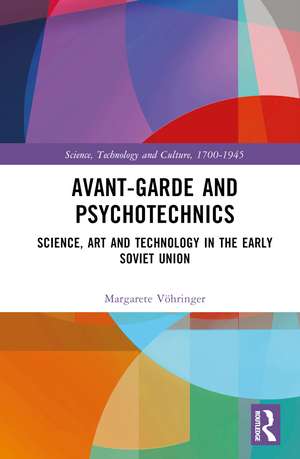Avant-Garde and Psychotechnics: Science, Art and Technology in the Early Soviet Union: Science, Technology and Culture, 1700-1945
Autor Margarete Vöhringeren Limba Engleză Hardback – 31 iul 2023
In 2007 Avant-Garde and Psychotechnics was acknowledged with an award for interdisciplinary research by the Wilhelm-Ostwald-Society, Großbothen. In 2011 the book received funding from the VolkswagenStiftung to be translated into English and Russian (the Russian edition was published by NLO books in 2019). The original German edition also received favorable reviews in NZZ, NTM, Derive, Junge Welt and Sehepunkte.
Din seria Science, Technology and Culture, 1700-1945
-
 Preț: 310.88 lei
Preț: 310.88 lei -
 Preț: 475.16 lei
Preț: 475.16 lei -
 Preț: 469.34 lei
Preț: 469.34 lei - 12%
 Preț: 299.52 lei
Preț: 299.52 lei -
 Preț: 469.34 lei
Preț: 469.34 lei -
 Preț: 469.34 lei
Preț: 469.34 lei -
 Preț: 489.26 lei
Preț: 489.26 lei -
 Preț: 464.12 lei
Preț: 464.12 lei -
 Preț: 489.26 lei
Preț: 489.26 lei - 30%
 Preț: 820.73 lei
Preț: 820.73 lei -
 Preț: 469.34 lei
Preț: 469.34 lei -
 Preț: 469.34 lei
Preț: 469.34 lei -
 Preț: 486.49 lei
Preț: 486.49 lei -
 Preț: 416.22 lei
Preț: 416.22 lei -
 Preț: 469.34 lei
Preț: 469.34 lei -
 Preț: 469.34 lei
Preț: 469.34 lei - 17%
 Preț: 259.98 lei
Preț: 259.98 lei - 17%
 Preț: 259.98 lei
Preț: 259.98 lei - 12%
 Preț: 299.52 lei
Preț: 299.52 lei - 30%
 Preț: 821.13 lei
Preț: 821.13 lei -
 Preț: 489.26 lei
Preț: 489.26 lei - 26%
 Preț: 248.30 lei
Preț: 248.30 lei - 26%
 Preț: 876.78 lei
Preț: 876.78 lei -
 Preț: 384.66 lei
Preț: 384.66 lei - 16%
 Preț: 261.54 lei
Preț: 261.54 lei
Preț: 1001.77 lei
Preț vechi: 1221.68 lei
-18% Nou
Puncte Express: 1503
Preț estimativ în valută:
191.68€ • 200.15$ • 158.29£
191.68€ • 200.15$ • 158.29£
Carte tipărită la comandă
Livrare economică 15-29 aprilie
Livrare express 08-14 martie pentru 34.30 lei
Preluare comenzi: 021 569.72.76
Specificații
ISBN-13: 9781032532646
ISBN-10: 1032532645
Pagini: 254
Ilustrații: 50 Halftones, black and white; 50 Illustrations, black and white
Dimensiuni: 156 x 234 x 16 mm
Greutate: 0.5 kg
Ediția:1
Editura: Taylor & Francis
Colecția Routledge
Seria Science, Technology and Culture, 1700-1945
Locul publicării:Oxford, United Kingdom
ISBN-10: 1032532645
Pagini: 254
Ilustrații: 50 Halftones, black and white; 50 Illustrations, black and white
Dimensiuni: 156 x 234 x 16 mm
Greutate: 0.5 kg
Ediția:1
Editura: Taylor & Francis
Colecția Routledge
Seria Science, Technology and Culture, 1700-1945
Locul publicării:Oxford, United Kingdom
Public țintă
Academic and PostgraduateCuprins
Introduction. 1. Feed(ing) Back: Nicolai Ladovsky’s Psychotechnical Laboratory for Architecture, Moscow 1921–1927 2. Networking: Vsevolod Pudovkin's Mechanics of the Brain – Film as Reflexology, Leningrad/Moscow 1925–1926. 3. Grafting: Alexander Bogdanov's Circular Blood Transfusions, Moscow 1924–1928. Conclusion: Feeding Back, Networking and Grafting as Cultural Techniques.
Notă biografică
Margarete Vöhringer is currently Professor for the Materiality of Knowledge at Georg-August-University Göttingen. Her research interests include materiality and aesthetics of the sciences, connections between art and science, history of collecting and exhibiting, Russian avant-garde, and cultural techniques of seeing. She has co-edited several anthologies: Sehstörungen. Grenzwerte des Visuellen in Künsten und Wissenschaften (with Anne Kathrin Reulecke, Berlin 2019); Wissenschaft im Museum – Ausstellung im Labor (with Anke Te Heesen, Berlin 2014) and Phantome im Labor: Die Verbreitung der Reflexe in Hirnforschung, Kunst und Technik. Berichte zur Wissenschaftsgeschichte 32(1), 2009 (with Yvonne Wübben).
Recenzii
Much has been written on the relations between the arts and sciences. Margarete Vöhringer's ambitious book goes further and explores ways, at a particular time and place, in which there were not separable ‘related’ activities but a common experimental practice with material things, in which all was ‘art’. The purpose is not to dissolve differences but to specify, in historical detail, the sharing and modification of material practices and instrumentation as they carry from one cultural setting to another.
Roger Smith, The British Journal for the History of Science, 2023:1-2
Roger Smith, The British Journal for the History of Science, 2023:1-2
Descriere
The book presents a different history of the Russian avant-garde and its cultural encounters with the sciences. It is focusing on the entanglements of architects, filmmakers and philosophers with experimental psychologists and physiologists in the 1920s which are hardly known yet.
